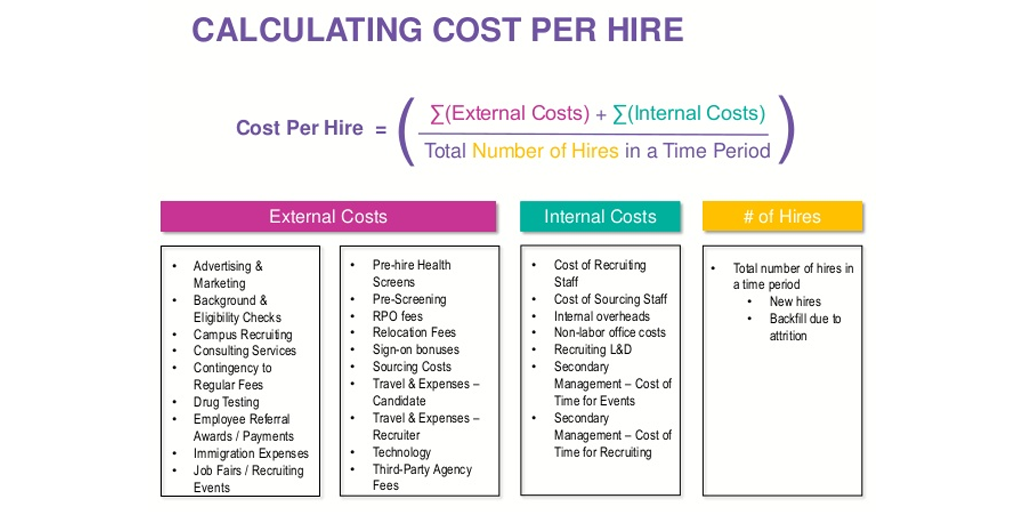Spending too much on recruitment, payroll or global HR?
We help you find the Best Providers at the lowest cost.
Cost per hire is a fundamental recruiting metric that measures the total expenses incurred in attracting and bringing new employees on board within an organization. This figure encompasses both internal and external costs, ranging from advertising job positions to interviewer time, and is instrumental in helping businesses gauge the efficiency of their hiring practices. Understanding and managing cost per hire is vital for companies looking to allocate their recruitment budgets effectively and predict future hiring needs.
Key Takeaways
- Cost per hire includes all costs associated with the hiring process.
- Accurate calculation requires comprehensive tracking of both internal and external expenses.
- Benchmarking cost per hire informs strategic recruitment and budgeting decisions.
Understanding Cost Per Hire
In the realm of human resources, Cost Per Hire is pivotal for gauging the effectiveness of recruitment strategies. It reflects the fiscal implications linked to the acquisition of new talent.
Definition of Cost Per Hire
Cost Per Hire is a recruitment metric that quantifies the total expenses incurred during the hiring process. These costs typically encompass sourcing candidates, advertising job openings, conducting interviews, and onboarding new employees. To compute this metric, one must add all internal and external costs associated with recruitment and divide by the number of hires within a specific timeframe. For instance, if the total recruitment expenses amount to $150,000 and 60 hires were made, the Cost Per Hire would be $2,500.
Importance of Measuring Cost Per Hire
Measuring Cost Per Hire is essential for organizations to benchmark their hiring efficiency. It provides a quantitative foundation to assess and compare the cost-effectiveness of various recruitment strategies over time. By keeping track of this metric, companies can identify potential areas for cost savings and make more informed budgeting decisions. This is not only critical for the HR department but also influences the overall financial health of the organization. It is widely recognized as a staple among recruitment metrics for any business seeking to optimize its talent acquisition process.
Components of Cost Per Hire
To accurately budget for hiring, organizations must understand the distinct elements that contribute to the total cost per hire. These are traditionally categorized into two key areas: internal and external recruiting costs.
Internal Recruiting Costs
Internal recruiting costs encompass the expenses related to the resources already within the organization that are used in the hiring process. This includes:
- Recruiter salaries: The compensation paid to in-house recruitment staff.
- Education and training: Costs associated with developing the skills of the recruitment team.
- Internal systems: Expenses for applicant tracking systems and other recruitment software.
- Interview costs: Time and resources spent by internal employees to conduct interviews.
- Background checks and drug testing: Conducting these necessary checks internally adds to the expense.
External Recruiting Costs
External recruiting costs are the expenses incurred when utilizing resources outside the organization. These costs typically involve:
- Agency fees: Payments made to external recruitment agencies.
- Job board fees: Costs for posting job openings on online job boards.
- Career fairs: Expenses for attending or hosting job fair events.
- Advertising costs: Funds allocated for marketing job openings.
- Travel expenses: Costs for candidates’ travel to interviews if covered by the employer.
- Relocation expenses: Financial assistance offered to new hires for moving to a new location.
Calculating Cost Per Hire
When organizations aim to optimize their recruitment efforts, understanding and calculating the Cost Per Hire (CPH) becomes vital. It measures the average cost associated with acquiring new talent, taking into account all expenses from job postings to onboarding.
Formula for Cost Per Hire
The standard formula for Cost Per Hire is straightforward: one adds all the recruitment expenses and then divides that sum by the total number of hires over a determined period. These expenses are classified into internal and external costs.
- Internal costs could include in-house recruiters’ salaries, internal recruitment technology, and overheads.
- External costs might encompass job boards, recruiting events, outside agency fees, and candidate travel expenses.
The formula can be expressed as:
Cost Per Hire = (Total Internal Recruiting Costs + Total External Recruiting Costs) / Total Number of Hires

Organizations may use a spreadsheet to track costs and calculate this metric more efficiently.
Example Calculations
Let’s consider an example to clarify the process:
- An organization spent:
$20,000 on internal recruitment teams and technology
$30,000 on external agencies and advertising Within a year, they hired 25 new employees.
Using the provided formula, their Cost Per Hire is:
$20,000 (internal) + $30,000 (external) / 25 hires = $2,000 per hire
Hence, the average cost per hire for that organization is $2,000. This figure helps businesses assess the efficiency of their hiring practices and pinpoint areas for cost-saving improvements, such as investing in more efficient recruitment technology.
Benchmarking & Industry Standards
When organizations aim to optimize their recruitment strategies, understanding industry benchmarks and adhering to established guidelines is crucial. These standards help companies gauge their performance against peers and manage costs effectively.
Industry Benchmarks
Industry benchmarks provide valuable data points that companies use to compare their talent acquisition costs with those of other organizations within their sector. The Society for Human Resource Management (SHRM) frequently compiles and disseminates industry benchmarks. They highlight key metrics such as executive cost-per-hire and overall recruitment expenditures. Benchmarks can vary significantly across industries due to factors like job complexity and market demand for certain skills. Detailed benchmarks, such as the SHRM’s Talent Acquisition Benchmarking Report, delineate these nuances and provide figures according to staff size and industry.
American National Standards Institute (ANSI) Guidelines
The American National Standards Institute (ANSI) sets forth guidelines to standardize the measurement of cost-per-hire, ensuring consistency and accuracy across organizations. These guidelines establish a framework for calculating and reporting hiring costs, incorporating both direct and indirect recruitment expenses. The SHRM has adopted the ANSI’s cost-per-hire standard, which provides specific considerations that help organizations maintain industry-standard practices. The Cost-per-Hire Standard outlines the structure for these calculations, allowing companies to align their strategies with recognized methodologies.
Strategic Factors Impacting Cost Per Hire
When assessing the cost per hire, one must consider specific strategic factors related to the role and department, as well as company size and industry. Each of these elements can significantly influence the recruitment budget and resources required.
Role and Department Factors
Certain roles, particularly those in high-demand or specialized fields, can carry a higher cost per hire due to the intensity of sourcing and competition for top talent. For example, technical positions in software development often require a more extensive search and higher salaries, which are reflected in the recruitment costs. Departments like engineering or research and development may experience this more acutely, scaling up their recruitment expenses. Additionally, seniority plays a pivotal role; hiring for senior or C-suite levels incurs a larger investment, not only in direct costs but also in the time and resources spent during the executive search.
Company Size and Industry Variables
Company size influences the cost per hire, with larger organizations potentially leveraging economies of scale, yet also possibly facing higher internal costs due to more extended hiring processes. Meanwhile, smaller firms often have leaner processes but may require external recruitment support, amplifying costs.
In terms of industry, variables such as turnover rates, talent scarcity, and regulatory requirements shape hiring costs. Competitive sectors like finance or technology often see a higher cost per hire due to the need for talent with niche skill sets. Conversely, industries with larger available labor pools might experience lower costs. These industry variables necessitate a tailored strategy reflective of market dynamics to optimize recruitment spending effectively.
Optimizing Recruitment Budget
To ensure efficient use of resources in hiring, organizations must strategically allocate their recruitment budget, considering both traditional costs and investments in innovative technologies.
Budgeting for Different Recruitment Costs
When budgeting for recruitment, it is critical to account for various expenses associated with attracting top talent. These costs can be broadly categorized into internal and external expenses.
- Internal costs might include salaries for recruiters and administrative staff, as well as overhead expenses associated with the recruitment department.
- External costs could involve fees for job boards, recruitment agencies, background checks, and advertising.
An AIHR article highlights the importance of considering both variable costs, like agency fees, and fixed costs, such as internal recruiter salaries, when creating a comprehensive recruitment budget.
Investment in Talent Acquisition Technology
Investing in talent acquisition technology is a forward-thinking approach to optimizing recruitment strategies. Two vital technologies that can significantly enhance recruitment efforts include:
Applicant Tracking Systems (ATS): ATS can streamline the hiring process, from posting job ads to managing candidate communications. By automating routine tasks, an ATS can lead to cost efficiencies and better candidate experiences.
Recruiting Software: Beyond tracking applicants, recruiting software often includes features for sourcing candidates, social recruiting, and advanced analytics to improve decision-making and reduce time-to-hire.
Investment in technology, as detailed by Workable, can also lead to a more predictable recruitment cost per hire, allowing for better budget allocation and an increase in the return on investment for each recruitment effort. By leveraging these tools, companies can gain a significant competitive advantage in the talent marketplace.
Improving Recruitment Processes
Efficient recruitment processes encompass strategies optimizing both the attractiveness of the company to potential applicants and the use of metrics to measure the efficacy of various hiring sources. By focusing on these aspects, organizations can streamline their hiring efforts to reduce the cost per hire and enhance overall recruitment efficiency.
Enhancing Employer Branding
Employer branding plays a pivotal role in attracting top talent. A strong employer brand reduces recruitment costs by enticing candidates to apply, thus decreasing the need for extensive outreach. It is integral to develop a positive company image that reflects the values and culture of the organization, as well as highlight career development opportunities. Companies invest in their employer brand by ensuring an active online presence, showcasing employee testimonials, and participating in community events to create an appealing image that resonates with potential candidates.
Refining Source of Hire Metrics
Utilizing source-of-hire metrics allows companies to identify the most effective recruiting channels. It is crucial to regularly review and analyze the performance of each source, be it job boards, employee referrals, or social media campaigns. By concentrating resources on high-performing sources, companies can optimize their recruitment strategy. A detailed breakdown of source effectiveness helps in fine-tuning the allocation of the recruitment budget, making the process cost-effective and targeted. They share this critical recruitment metric, confirming the significance of measuring the impact of each hiring source to inform better recruiting practices.
Influences on Hiring Quality and Speed
The duration and rigor of the hiring process have profound effects on the quality of hire and subsequent business outcomes. Making strategic decisions in these areas can significantly improve the efficiency and efficacy of talent acquisition.
Time to Fill and Time to Hire
Time to fill refers to the period from when a job requisition is opened until an offer is accepted. A shorter time to fill can be advantageous in rapidly changing industries but might compromise the quality of candidates if the process is too rushed. On the other hand, the time to hire starts when a candidate enters the recruitment process and ends when they accept the offer. Although a streamlined interview process can accelerate the time to hire, this efficiency mustn’t detract from the careful assessment of candidates to maintain the high quality of hire.
Factors that influence the time metrics include:
- The efficiency of sourcing channels: Effective channels can populate the candidate pipeline faster.
- Streamlined screening procedures: Reduction of bottlenecks in resume review and initial screenings can reduce delays.
- Responsiveness of the hiring team: How quickly interviews are scheduled and feedback is provided can impact the time to fill.
Impact of Recruitment Quality on Business Outcomes
High quality of hire is critical for achieving positive business outcomes. The correlation between the hiring process and eventual job performance is strong; thorough candidate evaluation leads to employees who can contribute more significantly to company goals.
Attributes of a high-quality hiring process include:
- Comprehensive job descriptions: These attract the right candidates and set clear expectations.
- Structured interviews: A consistent approach helps to fairly assess each candidate’s competencies.
Effective onboarding also correlates with improved job performance and satisfaction, which are key indicators of quality of hire. Comprehensive onboarding ensures that new hires are aligned with company culture and values from the outset, fostering a productive work environment.
Advanced Metrics and Forecasting
Advancing beyond the basic measurement of cost per hire, organizations are leveraging long-term recruitment metrics and predictive analysis to gain deeper insights and forecast future recruitment needs with greater accuracy.
Long-term Recruitment Metrics
Organizations that adopt a strategic recruiting approach understand the importance of assessing the Quality of Hire. This metric measures the value new employees bring to the company, considering their performance, the rate of retention, and their impact on overall business goals. It’s calculated by analyzing the performance outcomes and tenure of a cohort of hires over a specified period. Additionally, Recruitment Funnel Effectiveness indicators can help companies identify stages in the recruitment process that may require optimization for efficiency and effectiveness.
Predictive Analysis and Forecasting Recruitment Needs
Predictive analysis in recruitment allows companies to anticipate hiring needs and adjust strategies proactively. By analyzing historical data such as time-to-fill and applicant drop-off rates, a company can forecast trends and prepare for periods of high hiring demand. For example, If data shows that engineering roles take an average of 60 days to fill, the company can initiate hiring protocols well in advance to mitigate any potential talent gaps. Using models to predict future needs based on growth rates, seasonality, and business objectives transforms the reactive nature of recruitment into a forward-thinking, strategic function.
Leveraging Recruitment Technology
Recruitment technology has evolved to offer sophisticated tools that streamline the hiring process. Among these, Applicant Tracking Systems (ATS) and integration with social networks and job boards stand out as particularly effective in reducing cost per hire.
Benefits of Applicant Tracking Systems (ATS)
Applicant Tracking Systems (ATS) has become an invaluable asset in the recruitment process. They efficiently organize and analyze high volumes of applications, helping companies to identify suitable candidates quickly. By automating administrative tasks such as resume screening and interview scheduling, these systems reduce the time and effort associated with manual handling.
- Efficiency: An ATS can significantly accelerate the recruitment workflow, from posting job ads to candidate screening.
- Accuracy: With an ATS, the chances of human error are greatly reduced, ensuring that candidate information is processed correctly.
- Cost Reduction: Automating repetitive tasks cuts down on labor costs and helps to avoid the expenses associated with delayed hiring processes.
Integration with Social Networks and Job Boards
Recruitment doesn’t just happen within the confines of a company’s career site. Organizations that integrate their ATS with social networks and job board sites cast a wider net and tap into a larger pool of potential candidates.
- Wider Reach: Listing job openings on platforms like LinkedIn or Glassdoor extends visibility to a broader audience.
- Targeted Hiring: Social media channels allow for more targeted job ads, reaching individuals with specific interests and skills.
- Quick Posting: Integration allows a company to post jobs to multiple boards with a single click, saving time and ensuring consistency across platforms.
By harnessing recruitment technology, companies can optimize their hiring practices, drive down costs, and secure top talent more efficiently.
Legal and Compliance Considerations
In the process of hiring, employers must navigate a complex landscape of labor laws and compliance regulations to mitigate legal risks and unforeseen costs. A meticulous approach to compliance can protect an organization from costly legal challenges and penalties.
Compliance with Labor Laws
Hiring practices are regulated by various labor laws to ensure fair treatment of candidates and employees. Employers are required to adhere to Equal Employment Opportunity (EEO) standards and anti-discrimination laws which mandate that hiring decisions cannot be based on race, color, religion, sex, national origin, age, disability, or genetic information. Additionally, compliance with the Fair Labor Standards Act (FLSA) mandates proper classification of employees and adherence to wage and hour laws. Organizations must maintain detailed records to demonstrate compliance with these legal requirements.
In some jurisdictions, there are laws pertaining to “ban-the-box” initiatives that restrict or prohibit the inclusion of questions about criminal history on job applications. It’s crucial for employers to stay informed about such legal developments to avoid non-compliance penalties.
Budgeting for Legal and Compliance Costs
The costs associated with legal and compliance issues in hiring are multifaceted and must be carefully budgeted. This includes:
- Direct costs such as legal consultation fees, compliance training programs, and the implementation of compliant HR software solutions.
- Indirect costs linked to the administrative time spent by HR professionals ensuring policies are up-to-date, conducting internal audits, and addressing compliance-related queries.
Budgeting for these expenses is critical to avoid unexpected financial burdens. Organizations might consider best practices noted by sources such as SHRM and GoCo.io to estimate a realistic range for these costs. Proper investment in legal and compliance can offer significant returns by minimizing the risk of fines and legal disputes.
Hiring in new countries normally takes a long time and costs lots of money. Not with an EOR.
Hiring contractors in new countries normally requires weeks of legal paperwork and research on local compliance laws. With an EOR, hiring employees and contractors in 185+ countries just takes a couple of clicks.
By automating the contracting and invoicing process, an EOR lets you manage a global team all from one place. It’s the smartest way to hire and manage contractors in 1 or 100 countries.


